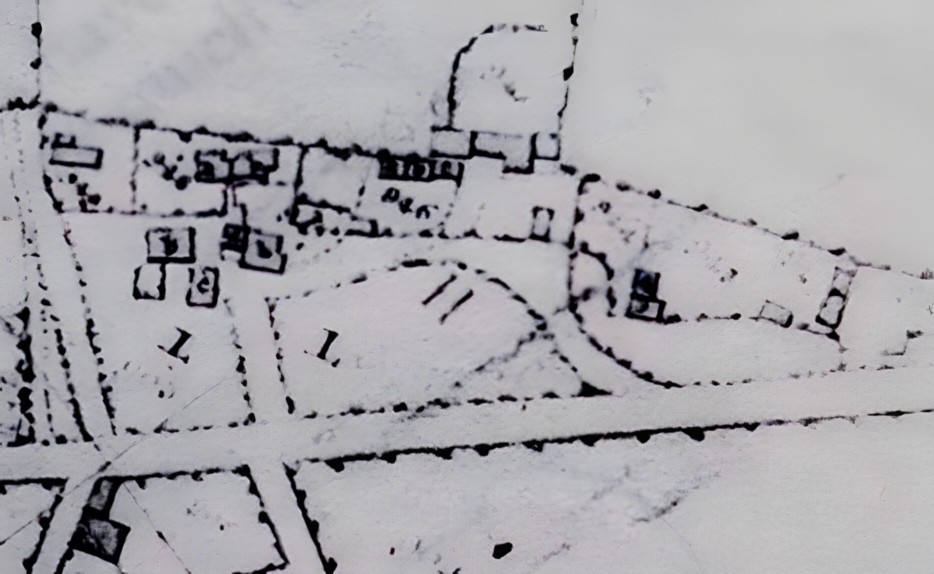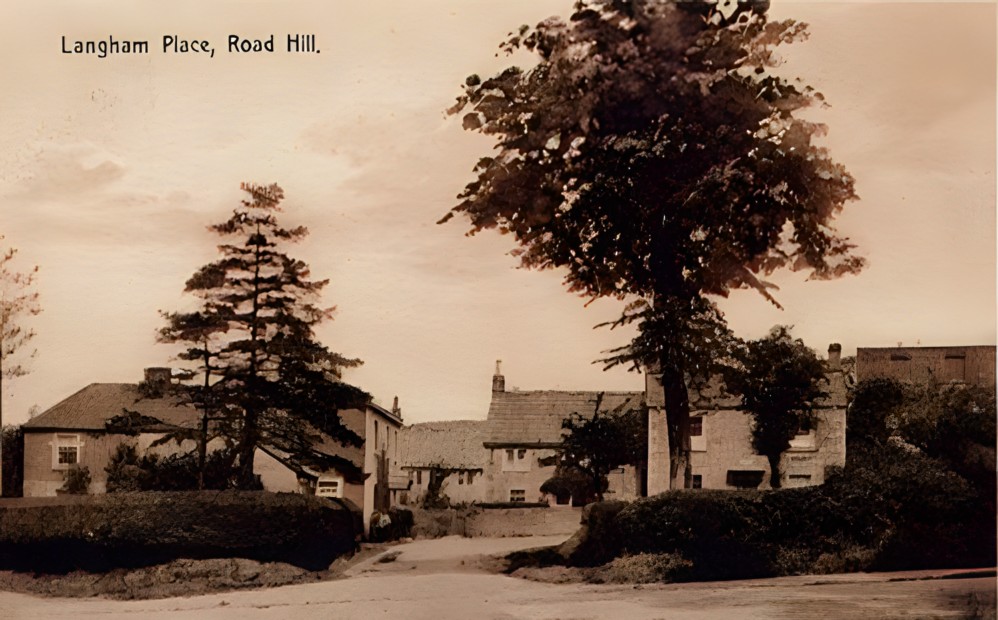1 Langham Place appears on the 1806 map as a new built house in the ownership of Thomas Whitaker Ledyard. It was still owned by the Ledyard family in 1843 and occupied by Rueben Grist. It has the characteristic stone brackets to the roof gutters which suggest it was renovated by Edward Silcocks in the mid 19th century.
3 Langham Place is shown on the 1806 map (see below) as an uninhabited building. By 1843 it was owned by Joseph Greenhill and occupied by Sarah Cabell.

5 Langham Place is listed as an early 19th century house and is thought to have been built with bricks from the Rode Brickworks. (See details of Rode Brickworks under section titled “More Houses”). It was described as a house and shop in 1806, owned by Agar Beverstock and occupied by Thomas Harvey. By 1843 it was owned by Joseph Greenhill and Absalom Webley was living here. Frank Woolley, carpenter and caretaker of the Jubilee Clock from 1894 to 1921, moved here with his family in 1908. His daughter, May Woolley, who had been born in the caretaker’s cottage at the Reading Rooms, lived here until she died in 1995 and left her estate to be divided between the Memorial Hall and the Playing Field.
The following document was found in a suitcase full of old documents relating to property owned by Arnold J Noad who died in 1950. The document related to a dispute between A J Noad and the Woolley family concerning the ownership and right of use of an outside privy. The document provides some history of a house near to the Woolley’s, but there is insufficient information to identify it.
“History of Cottage purchased June 1936
A J Noad
First document dated 1866 Mr Randall occupier 30 years (1883 to 1913); Mr Francis occupier 3 years (1913 to 1916); Mr S Humphreys occupier 14 (1916 to 1940).
It is known that from 1883 to 1937 the only lavatory accommodation was closet destroyed by Woolleys 14 Feb 1940.
From an Assent of the property of the late Arnold John NOAD dated 25 May 1951
THE SCHEDULE
Eighthly All that freehold dwelling house with the garden thereto adjoining situate at Rode Hill in the Parish of North Bradley in the County of Wilts and now known as Langham Place Rode aforesaid formerly in the occupation of Samuel Humphreys but now of Percy Harris and conveyed to the said Arnold John Noad by a Conveyance dated the twelfth day of May One thousand nine hundred and thirty six made between Ernest John White of the one part and the said Arnold John Noad of the other part.”

7 Langham Place is marked on the 1843 map as a house and garden owned by Joseph Greenhill and occupied by Mary Davis.
11 Langham Place (Langham Cottage). A square stone plaque above the door is inscribed WH 1721. The property is shown on the 1792 map as owned by a Mr. Beverstock. By 1806 it was owned and occupied by David Comell. In 1903, Frederick Curtis was living in the cottage. There is a well in the front but the garden belongs to the house on the right, Christchurch Cottage.
13 Langham Place (Christchurch Cottage) is listed as mid 19th century. Paul Stacey believed this to be another house re-built by Edward Silcocks and it is almost identical inside and out to 1 Langham Place. Certainly the 1806 map, shows there was a house built on the property at that time, which was substantially larger than 11 Langham Place. (See figure 23). At that time it was owned and occupied by Nicholas Beverstock. By 1843 it was divided into two tenements owned by Joseph Greenhill and occupied by Jane Norton and Job Jones. Both these maps show a couple of cottages standing behind 11 and 13 Langham Place (see figure 24) and these were removed by 1924.
15 Langham Place (Rosebay Cottage) is listed as early 19th century. It is marked on the 1806 map as land containing a non-residential building, owned and occupied by Agar Beverstock, but by 1843, Joseph Greenhill owned and lived at this property. In the 1851 census he was listed as a beer house keeper and in 1861 as an innkeeper near Christchurch. So it is a good guess that this property was once an inn or alehouse, and some think it was called the Chequers. In 1931, Edward Webb, insurance agent, lived here. Paul Stacey remembered when he was a child that some of the windows were bricked in.
Extract from A History of Brewing in Rode by Sidney Fussell and Brian Foyston, 2006:
“The Chequers: There is some evidence that this was no. 15 Langham Place (Rosebay Cottage), for a Joseph Greenhill who lived there is described in the 1851 Census as “Beer house Keeper”, and in the 1861 Census as “Innkeeper near Christ Church”. The name “Chequers” dates back to Roman times (and there was at least one wine-shop of this name at Pompeii). When the legions were on the march, and evening came, the humble soldier dossed down for the night where best he could, but the officers stayed at local inns, should they be convenient, playing board games to while away the hours. It was thus natural for mine host to hang out a sign to advertise facilities for games and gambling, and money lenders were usually at hand should an unlucky punter be in need of funds to pay debts incurred. The Chequer Board became associated with the lending of money, as it still is in some parts of Italy today. In Britain we still have our “Chancellor of the Exchequer” and the greater proportion of the 200 or so Pubs of this name listed nationally in Yellow Pages stand at junctions on our old Roman Roads.”
17 Langham Place is shown on the 1792 map as owned by William Nutt. He still owned the property in 1806 when it was divided into three cottages occupied by William Viner, William Nutt and William Reason. By 1843 Elizabeth Nutt was the owner and the cottages were occupied by John Wilson and Elizabeth Nutt, the third being empty.
19 Langham Place. To the left of the church is a small cottage which used to be the church school. It was built by subscription in 1834. It was called the National School and in 1861 Miss Maria Bridgeman was mistress. In 1894-5, it was enlarged for 150 children but the usual attendance was about 130. In 1898 Robert Smith was the master and Miss Susan Kinton was the infants’ mistress. By 1903, the school was called the Elementary School and the average attendance was down to 63. There was a new master J. Howell Pugh, but Miss Susan Kinton was still here as the infants’ mistress. Paul Stacey said that the school closed in 1922 but it was used after that date for various functions as late as 1948. The actual building used to extend out to where the front wall is today. There was a bell over the porch. To the left and behind the school is a house which was converted from the old stables for Christchurch and Daubeny House.
[Link to National School]